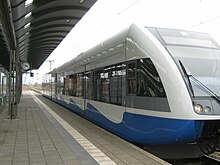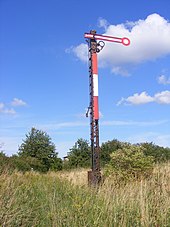Velgast train station
| Velgast | |
|---|---|
|
Entrance building of the Velgast train station
|
|
| Data | |
| Location in the network | Separation station |
| Design | Through station |
| Platform tracks | 3 |
| abbreviation | WV |
| Price range | 5 |
| opening | June 1, 1889 |
| Profile on Bahnhof.de | Velgast |
| location | |
| City / municipality | Velgast |
| country | Mecklenburg-Western Pomerania |
| Country | Germany |
| Coordinates | 54 ° 16 ′ 38 " N , 12 ° 48 ′ 11" E |
| Railway lines | |
|
|
| Railway stations in Mecklenburg-Western Pomerania | |
The Velgast station is the train station in the Mecklenburg-Vorpommern community Velgast . It is located at 19.0 kilometers of the main Stralsund – Rostock line and is the starting point of the Velgast – Barth – Prerow Darßbahn , which is only operated to Barth today. From 1894 to 1995 the Franzburger Südbahn (FSB) to Tribsees began on the station forecourt .
history
Opening of the Velgast train station and development into a hub (1894–1890)
Velgast station was opened on June 1, 1889 when the Stralsund – Rostock railway was opened . Initially, however, no train station was planned in Velgast, because the first plans for the Stralsund - Rostock route envisaged a route via Barth and Damgarten . Due to the very high construction costs of this variant, a second draft was developed, which provided for a route via Velgast. This variant was ultimately also implemented. The city of Barth was connected to the national railway network via a branch line from Velgast. This line opened on July 1, 1888, almost a year earlier than the main line. In 1910, the line called " Darßbahn " was extended to Prerow .
In addition to the line to Barth, the starting point of the Franzburger Südbahn line was built south of the station building on the station forecourt. First of all, the Velgast – Ravenhorst section went into operation on November 23, 1894. The Ravenhorst – Tribsees section followed on May 19, 1895. In addition, a branch line to Franzburg was built from Neu Seehagen, which was closed in 1968.
Further development up to reunification (1890–1990)
In 1971 and 1972 the superstructure between Ribnitz-Damgarten and Stralsund was comprehensively renewed. The Velgast train station also underwent some changes to the tracks and switches. Around 1980 the water tower was blown up surprisingly.
Since Velgast was both the branch office of the railway maintenance department and the Stralsund signaling and telecommunication maintenance department, more than 40 railway workers were working at the station in 1978.
As part of the electrification of the Deutsche Reichsbahn route , work began in Velgast in 1989. However, due to the political change and the subsequent reunification of Germany , electrification could only be completed in 1991.
From reunification to the renovation of the station (1990–1999)
After the reunification - as in many other parts of Eastern Germany - train traffic declined on all routes. Even in the GDR era it was known that the route to Tribsees was no longer economical. At that time, however, it was still indispensable due to freight connections and school traffic. Even after the fall of the Wall, the connection - primarily due to school traffic - lasted until 1995. On May 27, 1995 the last train from Velgast to Tribsees left for the time being. One year later, on April 27, 1996, the very last special trip with a historic railcar took place on the route. In 1997 the DB AG finally removed all connecting tracks to the main line.
Station renovation (1999)
As part of the German Unity Number 1 traffic project ( Lübeck – Rostock – Stralsund), Velgast station was completely rebuilt as part of the modernization of the main line. On September 26, 1998, the last scheduled passenger train reached the old Velgast station. One day later, the line was completely closed for the upcoming construction work and a replacement bus service was set up. From an economic point of view, the total closure was the only sensible way to comprehensively modernize the route in a relatively short period of time.
There was still some preparatory work to be done in the station itself. A few more train journeys had to be made for the construction trains that removed the rails and overhead lines . In addition, the station building had to be handed over "swept clean" by the supervisor.
The track systems were adapted to the new conditions. So 3 platform tracks and a siding were created. The latter mostly still consists of old rails that were probably re-laid here after the renovation. There is also a siding on Ladestrasse , which was used again for the first time in 2011 as part of a stone loading for the Barther Molenbau.
In the course of the route renovation, an electronic signal box (type El L ) was built on the station forecourt near the loading ramp , which is still manned around the clock. The construction work necessary for commissioning was completed at the beginning of June 1999, so that the first test trains could run from June 10, 1999, which served railroaders to explore the new line. On June 13, 1999, regular operations were resumed with a special timetable . Since all the other tracks except for one track still served as construction tracks and had not yet been opened to traffic, the Velgaster station was initially only accessible as a single track. For this reason, IC trains have not stopped here. On September 26, 1999, the new electronic interlocking went completely into operation. Thus all tracks were passable again.
Investments
The station was changed significantly through the renovation of the station. After the renewal of all tracks and platforms, Velgast got a decent platform roof. It is noteworthy that the architectural solution of this construction corresponds to that of the Lehrter Bahnhof (today Berlin Hbf ). The Gerkan architecture firm was also responsible in Velgast .
Track and platform systems
The transition from platform 1 to platform 2/3 was secured by a manually operated barrier before the renovation , but replaced by a tunnel during the renovation . To this day, the tunnel is regularly under water during heavy rain and thunderstorms, which is very annoying for travelers.
Since the renovation, Velgast station has had four tracks, three of which have a platform. Tracks 1 (on the main platform ) and 2 are used for the main line, while track 3 on the central platform to track 2 is used exclusively for UBB trains in both directions. The adjacent track 4 is used exclusively for parking trains.
Waiting room and ticket issuance
The waiting room and the ticket office were also completely renovated when the station was rebuilt, but are no longer accessible to travelers. The counter was closed in 1999. The ticket machine installed as a replacement was dismantled in 2008. Today, tickets can no longer be bought at Velgast train station. Since then, these have only been available on the train. In 2010 a passenger information system was installed as part of the federal economic stimulus program . The display cases on the platforms now also provide more information about train traffic.
Security technology
Since the route renovation, Velgast station has had an El L- type electronic signal box , which, in addition to Velgast, also controls the Langendorf , Martensdorf , Buchenhorst , Altenwillershagen and Ribnitz-Damgarten Ost stations . The signal box is still occupied. The original plan was to connect it to the operations center in Berlin in 2006 . This was not possible due to technical problems. Therefore, the route will probably continue to be served from Velgast in the future.
Before the renovation, Velgast was served by two signal boxes. First through the dispatcher interlocking Vaf , which was located in the station building, then through the switchman interlocking Vwt , which was located at the western end of the station at the exit towards Rostock or Barth.
Goods area
The loading street had a weighbridge and a turntable at the western end of the station. At the exit in the direction of Barth there was also a water tower that ensured the supply of the steam locomotives . At track 8 there was a loading ramp where numerous vehicles (especially agricultural machinery and military equipment) were loaded.
Other equipment
Furthermore, there was a station supervisor, a ticket office and even in the reception hall of the station Velgast Mitropa - restaurant .
traffic

The most important connection on which the Velgaster train station is located is the Stralsund – Rostock railway line . In addition to the Rostock - Stralsund - Lietzow (Rügen) - Sassnitz / Binz ( Hanse Express ) regional express trains , there are also individual ICE trains that connect southern Germany via Hamburg with Binz on Rügen and also stop in Velgast. By UBB web (UBB), on a part section of the former Darßbahn wrong is Barth connected.
Train connections (as of December 2017)
| line | route | Clock frequency |
|---|---|---|
| ICE 26 | ( Ostseebad Binz -) Stralsund - Velgast - Rostock - Hamburg - Hanover (- Frankfurt (- Karlsruhe )) | four pairs of trains daily |
| IC 30 | Ostseebad Binz / Greifswald - Stralsund - Velgast - Rostock - Schwerin - Hamburg - Bremen - Dortmund - Cologne - Mainz - Stuttgart | two pairs of trains a day |
| line | Line course | Cycle (min) | EVU |
|---|---|---|---|
| RE 9 | Rostock - Ribnitz-Damgarten - Velgast - Stralsund - Mountains on Rügen - Lietzow - Sassnitz | 120 | DB Regio Nordost |
| RB 25 | Velgast - Saatel - Kenz - Barth | 80/40 | DB Regio Nordost |
Web links
- Description of the station on ostseestrecke.de
Individual evidence
- ↑ michaeldittrich.de. Retrieved August 24, 2014 .
- ↑ Query of the course book route 190 at Deutsche Bahn.
- ↑ Querying the course book route 192 from Deutsche Bahn.

